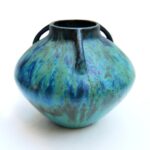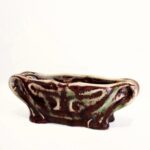Pierre-Adrien Dalpayrat
Biography
Pierre-Adrien Dalpayrat (14 April 1844 – 10 August 1910) was a French ceramist of international renown, born in Limoges. He began his artistic training in 1859 at the local drawing school, followed by the practical school of porcelain painting. Early in his career, he joined the Jules Vieillard et Cie factory in Bordeaux, where he married Marie Tallerie on 17 May 1866.
Dalpayrat’s professional path was itinerant during the 1870s: he worked at Léon Sazerat’s factory in Limoges, the Ashwin factory in Valentine, and the Fouquet factory in Toulouse, where his daughter Julie was born in 1878. He subsequently managed François Blanc’s workshop in Monaco and briefly relocated to Menton before returning to Limoges following the 1887 earthquake that destroyed the Menton workshop.
In 1889, Dalpayrat established his own factory in Bourg-la-Reine. His workshop employed his wife Marie and their children Albert, Adolphe, Hippolyte, and Paul. Dalpayrat specialized in stoneware, achieving international acclaim for his signature “Dalpayrat red,” an ox-blood red glaze obtained through careful control of copper oxide, firing atmosphere, temperature, and timing.
He collaborated extensively with the sculptor Alphonse Voisin-Delacroix (1857–1893) under exclusive contracts, producing celebrated works that were exhibited in Paris, Chicago (1893), Brussels (La Libre Esthétique, 1895), Liège (1895), St. Petersburg (1896), and Moscow (1897). Other collaborations included the Swedish artist Agnès de Frumerie (1896–1937).
His contributions were recognized with numerous awards: a gold medal at the Marseille Industrial Exhibition (1893), honorary diplomas at decorative arts exhibitions in Nantes (1896) and Paris (1897), a gold medal at the 1900 Exposition Universelle, and the title of Chevalier de la Légion d’Honneur. Despite these successes, financial difficulties periodically forced him to shift production toward more classical earthenware, and his factory ultimately closed in 1906.
Dalpayrat retired to Limoges, where he died on 10 August 1910, leaving a lasting legacy in the revival of European ceramics at the turn of the century.




